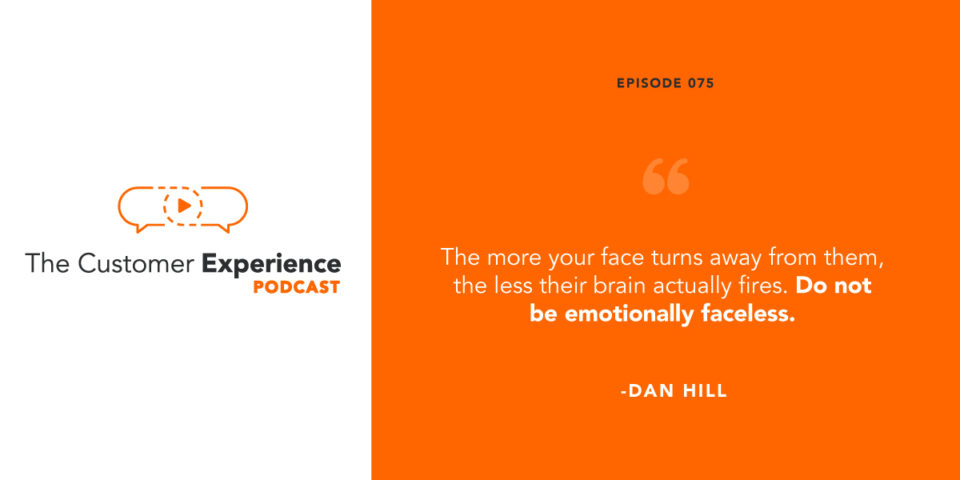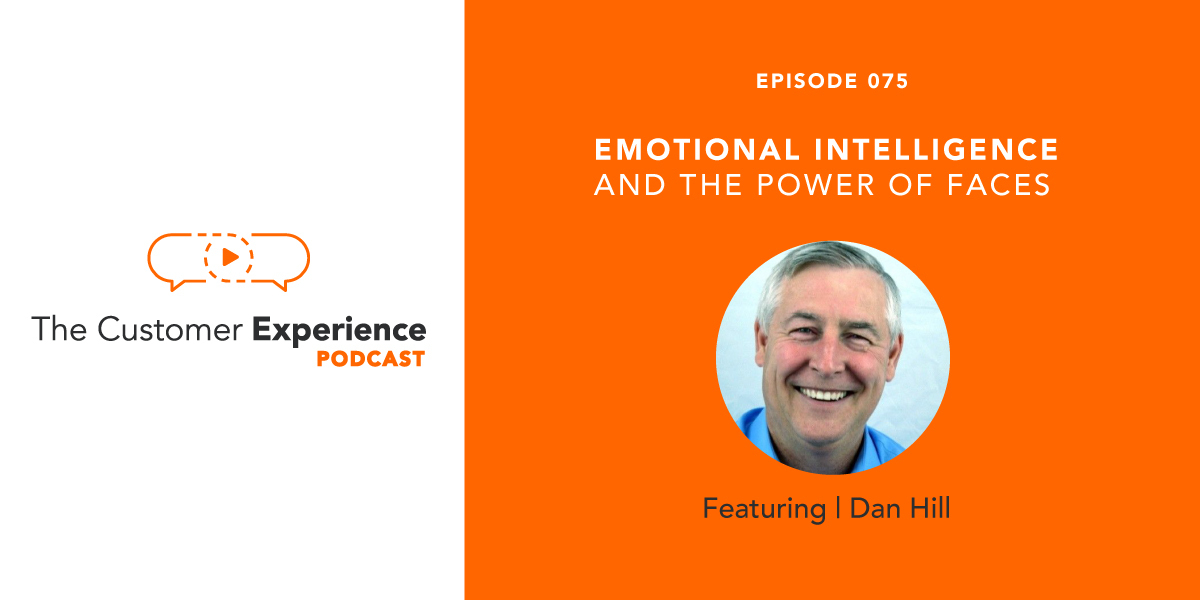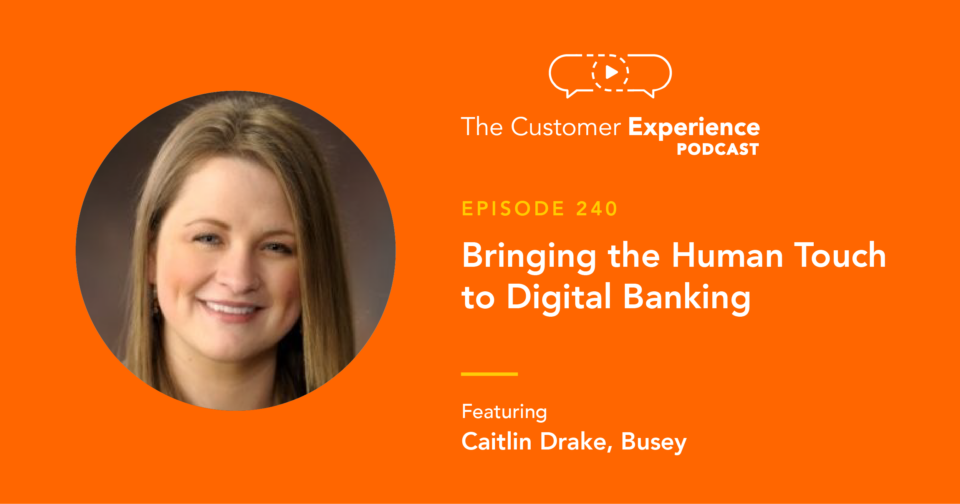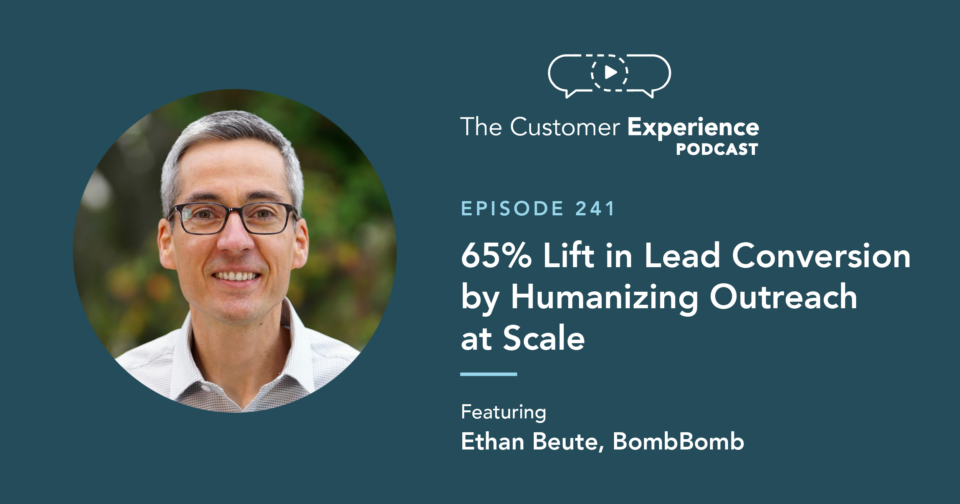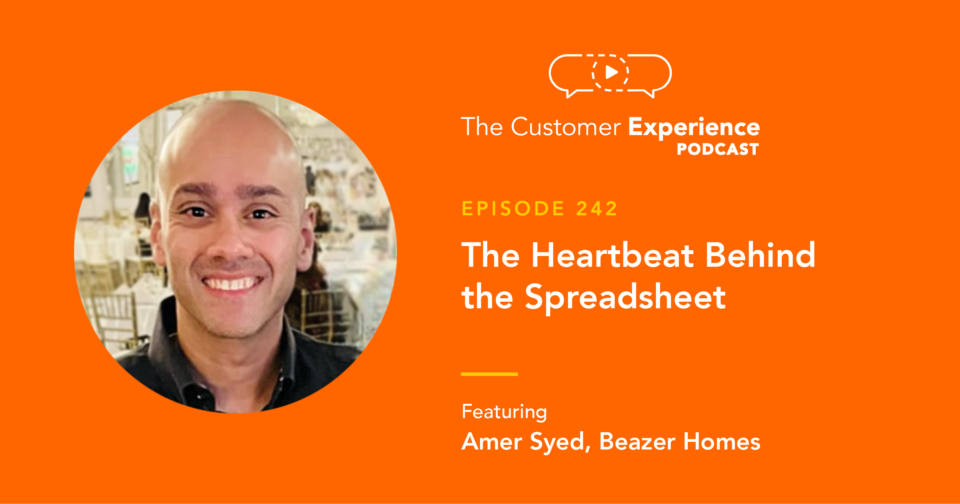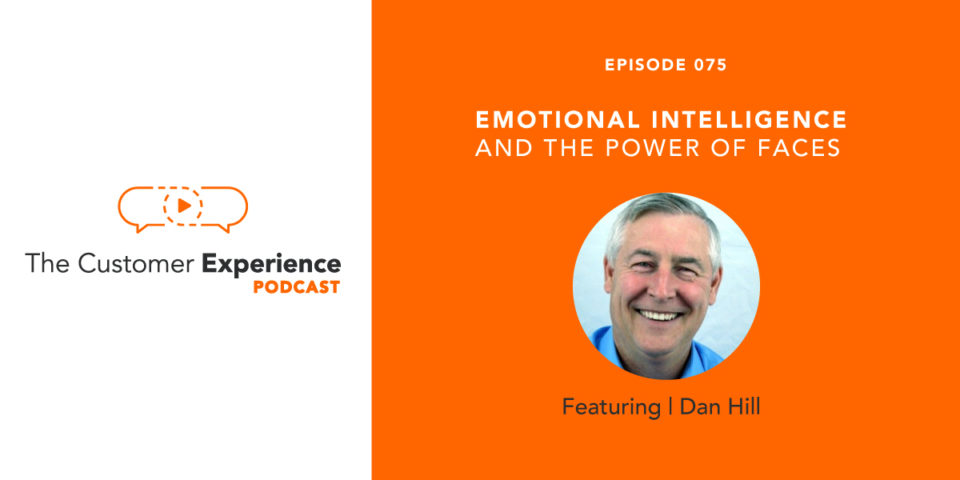
Listen to “75. Emotional Intelligence and The Power of Faces w/ Dan Hill” on Spreaker.
Apple Podcasts | Google Podcasts | Stitcher | Spotify
If the customer experience is based in how you make people feel, then emotional intelligence is one of the most important skills we can cultivate.
You see, the success of your business is built on a foundation of relationships. And you build, maintain, and grow them through trust and rapport supported by emotional connection.
And when it comes to reading these human emotions, the face is “the richest visual territory on the plant,” per today’s guest. Facial expressions truly reveal what is happening on the emotional scale; the power of faces is in how much they communicate to others. And facial expression of emotion is both universal and innate; we all do it and we all do it the same way.
Use emotional intelligence to your advantage, and it’ll shape your company’s entire customer experience – and employee experience.
Today’s guest on The Customer Experience Podcast, Dan Hill, Ph.D., has literally written the playbook for decoding facial expressions to understand human emotion.
He has brought facial coding outside of academia and into the B2B world. And he teaches us how to understand what the 25 square inches of the human face reveal.
Dan is President of Sensory Logic and expert on all things EQ (Emotional Intelligence). He’s authored several books including, “Emotionomics: Leveraging Emotions for Business Success” and “Famous Faces Decoded: A Guidebook for Reading Others.”
His market research from over 50% of the world’s top 100 B2C companies has helped him pioneer facial coding. Dan also holds seven U.S. patents related to the analysis of facial coding data.
In this episode focused on emotional intelligence and the power of faces, we talk about…
• Why customer experiences is capture in emotion
• What the origins of facial coding consist of (and the Mona Lisa decoded)
• How to frame your face properly in video
• Why emotion is important on camera and in person
• How facing the camera impacts your videos
Emotional Intelligence and The Power of Faces
Hear the entire conversation with Dan Hill on emotional intelligence, facial coding, and beyond, right here:
Listen to “75. Emotional Intelligence and The Power of Faces w/ Dan Hill” on Spreaker.
Hear any and every episode of The Customer Experience Podcast in:
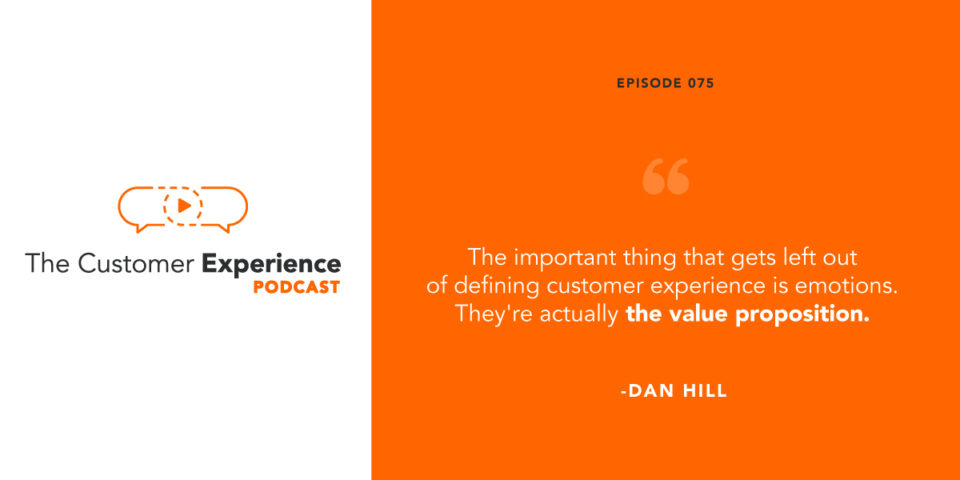
Full Transcript: Emotional Intelligence and The Power of Faces
Ethan Beute:
Unless your job is about to be automated, your successes state in your ability to build trust, rapport, and relationships with other people; hiring, selling, and negotiating; interacting with your boss, your team members, and your customers; even connecting with your family members and friends. Today’s guest is an expert on emotions and he can help us do all of these things more effectively. He’s the founder and president of Sensory Logic, a company that’s done market research for half of the world’s top 100 B2C companies. He pioneered the use of facial coding in business more than 20 years ago. He’s received seven US patents related to advanced methods to analyze facial coding data. And he’s the author of several books, including Emotionomics: Leveraging Emotions for Business Success, First Blush: People’s Intuitive Reactions to Famous Art, and Famous Faces Decoded: A Guidebook for Reading Others. Dan Hill, welcome to The Customer Experience Podcast.
Dan Hill:
Well, thank you so much, Ethan, for that very kind introduction.
Ethan Beute:
Sure. I really appreciate the body of work that you’ve generated over your career, and I’m really excited for the conversation. We’re in this age where technology is so well advanced that we’re really questioning in a variety of ways or a variety of conversations that are around what does it mean to be human. And certainly, in the context of creating and delivering a customer experience, there’s this kind of tech-human divide or blend is forcing a lot of these conversations.
Dan Hill:
Yeah, no. Emotions are really important. So dollars and emotion emotions, those are the two currencies in the world.
Ethan Beute:
Good. I love it. Great precursor to the conversation. Before we get going on customer experience in particular, you’re in the Minneapolis St. Paul area. I’d love for you to share, and we’re recording this on Thursday, April 2nd. Could you share what’s the current state of affairs there regarding the coronavirus pandemic? How’s it affecting you or your family, your team, your customers? Just what’s going on where you are?
Dan Hill:
Sure. Well, we have a pretty proactive governor, so we’ve gone into virtual lockdown mode and people are being asked to stay home. So we were a bit ahead of the curve on that. Fortunately, we’re behind the curve. We are not New York City. We have about 500 cases so far, but they are ramping up. About every three days we double. And probably the closest epicenter for us is Chicago and then Michigan beyond that. So obviously it’s coming our way, but the expected peak is late May.
Ethan Beute:
Okay. Well, very best to you all.
Dan Hill:
Thank you.
Ethan Beute:
I’m sure it’s one of the more interesting things that’s happened in your lifetime. It certainly is for me.
Dan Hill:
It certainly puts emotions front and center for all of us. And I actually have both a sister-in-law and her daughter who are nurses on the frontline in Chicago and in DC, respectively. So we very concerned, but also really proud of the efforts they’re making.
Ethan Beute:
Yeah. I can imagine on both accounts there. So let’s get into it, Dan. And again, best to your family. I really appreciate what they’re doing. When I say customer experience, what does that mean to you? What does it conjure?
Dan Hill:
Well, it conjures that there are a lot of touchpoints and you have to keep track of all the different angles. It’s a bit like playing pool. You don’t know how you got to get the ball into the pocket, but you got to try. Everyone has an experience interacting with a company. It can be good. It can be bad. It can be indifferent. Way too often it’s indifferent or even downright frustrating. I think the important thing that gets left out of defining customer experience is that emotions are going to come with it and they don’t just come with it. I think they’re actually in many ways the value proposition. We are going to remember the searing emotional experience for a long time. And that plays right back to the value of what we bought and to the brand equity for the company. So experience equals emotions in my game.
Ethan Beute:
Really, really good call there. Obviously you hit several of the key themes that I hear repeatedly in asking a variety of smart people that question, including yourself, and that it’s every touchpoint. It’s happening whether you intend for it to be happening or not. You said positive, negative, or indifferent. And then again, that emotional component leaves us with the thoughts and the feelings that become our online reviews, the stories we tell other people, or to be indifferent just as if it just didn’t even matter at all.
Dan Hill:
Yeah, no. Emotions are really contagious. They’re contagious between the people you’re interacting with and they’re contagious in terms of what you’re going to share with other people. To underestimate the power of emotions is basically to buy a ticket toward bankruptcy in my opinion.
Ethan Beute:
Sure. So talk a little bit more about the emotional components of the customer experience or even the employee experience. You’re attuned to a barometer of value. You already referred to that a little bit. But just break that down a little bit more from a practical standpoint.
Dan Hill:
Yeah. Well, I think we can even talk in terms of the evolution of customer experience, which I love, because you’re now trying to look at the holistic picture and how you’re going to design it, how you’re going to measure it, implement it, all of that. So it’s really a creative exercise. And the nice thing is it’s a lift up from what we used to have, which was simply there was a customer service department. What did that really do? That was the catch basin at the end of the process. And what it meant was I didn’t get any customer service. I didn’t get any customer satisfaction. And the entire emotional dynamic around that was essentially fear because you had the poor person who probably wasn’t really very empowered by the company, not so well paid, maybe a fairly recent hire within the company. They’re just trying to learn all of the processes and procedures. And now they have this ballistic missile coming at them, which is the unhappy customer.
Dan Hill:
Fear is not a lubricant for good communication. I mean, what do you do when you are fearful? You either fight. So now you’re going to have a confrontation between the two parties. You’re going to flee. So you basically try to avoid them. Or you freeze. And freeze is really likely because you’re stuck behind the desk or on the phone with somebody and they don’t hear you, you don’t hear them and nothing good happens. So it is so wonderful that the customer experience is trying to climb out of that because it really needs to start early on and we need to bring some other emotions besides fear into the equation, quite obviously.
Dan Hill:
So in my terms and facial coding terms, there are seven emotions. They are the playbook. And there is happiness, which is the only truly positive emotion. And we can talk about variations of that, like delight and relief and pride and hope, but that’s essentially your one positive emotion. There is a neutral emotion, surprise. And you can have a positive surprise. I got a new car for Christmas. You can have the negative surprise. They got a new car accident on the way home from work. So that’s your neutral emotion that’s going to go one direction or other. And then we have to deal with anger and sadness and fear and disgust and contempt. And I’m sure we’ll get into those, but that’s essentially the playbook. If you’re really going to do customer experience well, you need to take into account where are those dynamics could play out? What could be the triggers? How do I get out of the, what I call the speed bumps, the negative emotions. And how do I accentuate the positive?
Ethan Beute:
Really good. I am with you as a customer. Of course, everyone that’s on the show, of course, is customers. We’re all customers in addition to trying to manage some aspect of a business and in service of customers. I love that the competitive environment has really forced customer experience back up into the conversation and really forced a lot of companies to think a lot more about it. And you’re absolutely right. So many unempowered people, I’m thinking now historically, hopefully, it’s not happening too much anymore, although in canceling a bunch of travel here in first and second quarter, I certainly dealt with people who are not empowered to make decisions and to really serve the customer. And to your point, it’s just like any situation fight or flight or freeze. And I came in hot on a customer service rep on the phone the other day, and she just immediately turned it around for me. So there are a lot of people doing these things well. And again, I think the business environment on both the customer and the employee side has forced companies to be better about this and to probably start acting more in the service of their employees, not just their customers.
Dan Hill:
Yeah. And you’re dealing with a person. I mean, this is all we can … We talk about B2B and B2C. It’s B2P, it’s business to people. You work with people, you sell to people. If you go back to the traditional format of the customer service, they come with a story because really it’s their personal worth that’s on the line at this moment. They feel like they made a mistake. They bought something. They didn’t get what they expected. The company is bigger than them and has their money. And yeah, they want their money back or they want satisfaction, but they also want to be validated as a person which involves actually listening to them. And if you truly listen to them, you’re also going to take into account their emotions. So to me, it’s so important for people to lift their emotional IQ, their EQ.
Dan Hill:
I have sometimes at market research conferences put out the easiest test in the world, seven emotions. I don’t even give them a fake eighth choice. Seven emotions, and here’s the essence, the single word that would describe what that emotion is about. And all they have to do is they match and sort, and the accuracy rate is about 35%. This is market researchers who think about business dynamics hopefully day in, day out on their job at least. 35%. So there is a lot of headroom that we can improve on to be better at this.
Ethan Beute:
Yeah. Let’s spend a minute on EQ and then we’ll maybe get into facial coding in business in particular. What have you seen over the years? I mean, obviously you’re still setting up this quiz, which is essentially … You’re probably expecting the outcome that you’re getting because you’ve done it enough times. But what’s the state of affairs in your view on emotional intelligence, EQ, in popular business culture?
Dan Hill:
Well, I think it’s certainly improved. When I came in, in 1998, I mean, I was an absolute pioneer in every sense of the word. No one had heard of facial coding outside of academia, that’s for sure. And I wanted a tool that would allow me to capture and quantify emotions, and I knew we had to bring science with it. So yes, Daniel Goldman had come out with his book on emotional intelligence and I think it was 1995, and that was a big bestseller. But I think it got applied a lot more in personal life than it got applied in business life. I have had so many people come up to me in private and say, “Thank God someone is raising these issues.” And also probably, quite honestly, they got us a guy, because it was a woman in stereotypical business environments that might seem like it’s too soft or fluffy or doesn’t go to the bottom line. And I knew I had to hard case it. I had to have numbers. I had to have science. I had to have a process. So I think it’s moving that direction. There are constantly articles out in the popular press talking about breakthroughs in brain science and validating how much we’re emotional decision-makers. But you have to keep pounding and pounding at it. There are just people who don’t want to go there. It just happens.
Ethan Beute:
Yeah. So let’s get into a little bit then of that harder science, the facial coding, the analysis, the data collection and the analysis of that data. Talk a little bit about that process. And then to the degree, you can for listeners, just make it really practical for people that aren’t necessarily going to undertake some kind of a project inside their organization. What are a few things they can take away from everything that you’ve learned and taught around collecting the data and analyzing it?
Dan Hill:
Okay, well, I’ll see if I can take 20 years and put it into five sentences.
Ethan Beute:
Right, right. Or five minutes.
Dan Hill:
Yeah. That’s fine. Let’s start with facial coding. I think a really fun way to introduce it is Mona Lisa. Leonardo da Vinci was probably the world’s first great facial coder. He got into studying anatomy. He wanted to know which facial muscles created which emotions. And so we talk about Mona Lisa’s smile. The Mona Lisa actually also shows contempt and anger and disgust and fear. All of those sorts of things are going on for her. What da Vinci realized was that the 25 square inches that feature our eyes, nose and mouth is the richest visual territory on the planet.
Dan Hill:
The next person who brought this along was Charles Darwin. He essentially said to himself, “We must have emotions for a reason. They must give us an adaptive advantage.” And they can in business help us survive and thrive. The face is, as he validated, the most valuable way to understand what’s happening for somebody else. It’s the only place in the body where the muscles attach right to the skin. So it’s quick, real-time data. It’s universal. Even a person born blind emotes the same way as you or I. So the underlying physiology is the same, even if sometimes the degree at which the expressiveness happens can vary by cultures. You could argue Brazil and Japan are polar opposites. One is completely exuberant and one is much more subtle.
Dan Hill:
And finally, we have more facial muscles than any other species on the planet. But in practical terms, there is a man named Paul Ekman that I learned facial coding from. And Paul spent about a decade-plus systematically figuring out which muscles correspond to which emotions. So I gave you the seven emotions earlier and there are 23 expressions that go to these emotions. Sometimes they go to a single emotion. Sometimes they go to two or three, for instance. So one thing that Mona Lisa shows is her chin pulls up. It’s kind of a chin riser. That is a sign of anger, sadness, and disgust. She also shows contempt. The core of the mouth lifts up in a way. It’s a smirk. Think of Snidely Whiplash, the old cartoon character. He was contempt personified. Her lower eyelid is taut and straight. That is a sign of anger.
Dan Hill:
And finally, yes, there’s a smile, but it’s a rather muted smile. And all these other emotions are going on in her face. That’s why Mona Lisa is so fascinating. She’s unusually complex. But really when you have someone who you’re interacting with on behalf of your company, a customer, it may be a Mona Lisa or maybe something simpler, but it is really helpful to know what you’re dealing with.
Ethan Beute:
So for anyone listening, we write these up and we share video clips at bombbomb.com/podcast. I’m going to see if I can find a rights-free image of Mona Lisa to embed in here or you can obviously go out and search on its own. I think everything we just heard, you’re going to want to look at that painting while you maybe bounce back with the 30 seconds, 60 second back button and take a look at it. I know I’m going to do that when we’re done with this conversation.
Ethan Beute:
So universal and innate are two qualities of facial expression of emotion. We all do it approximately the same way and we all do it intuitively from birth. We write these emotions to our faces and we can read them from other people’s faces intuitively as part of the human experience. So for a leader or a frontline employee or for someone who is engaging maybe as a customer with a company, with a person at a company, what are a few tips? Can we master or improve our ability to read these or be more sensitive to them or manage the way we express these emotions? Or are there maybe communication channel consequences if we’re particularly angry or frustrated or confused? Are there channels we should or shouldn’t use? Make it one step more practical.
Dan Hill:
Sure. Well, first of all, in my book, Famous Faces Decoded, I essentially offer up the secret sauce. For the longest time, I kept it to myself what Dr. Ekman had taught me. And he had a very complicated manual, 500 pages plus, pretty academic in nature. I made it a lot more fun. First of all, it’s shorter. Second of all, I used celebrity examples with arrows and circles. So you can see the expression on the faces of rock stars and Hollywood movie stars and famous politicians and so forth. So that, I think, hopefully, makes it a lot more accessible. Sorry. I forgot to turn off the phone. You may have to edit it out.
Ethan Beute:
Yeah, no problem. We can edit.
Dan Hill:
Okay. So let me try … To make it a lot more fun, I think, was the last thing I was saying. In terms of practicality, yes. Let’s take it from different angles. If you are someone in senior management, you need to think about who you’re hiring even if you’re a manager, one step removed from the front lines. Southwest Airlines, of course, famously part of hiring is what kind of rap can you give to the people on board the airplane? Are you amusing? Are you likable? Do you bring some energy? And that last point is pretty good because your emotions turn on when something matters to you. I mean, there are all number of wives who complain that talking to their husband is like talking to a brick wall. Well, you do not want that as a customer dealing with someone on the front lines either.
Dan Hill:
So your emotions turn on, again, when something matters to you. Motivation and emotion have the same root word in Latin, to move, to make something happen. So show you care, show, you’re going to get something done on their behalf. I would not want to hire the person with a totally flat affect. That is essentially a cold fish. The other thing I think that’s important if you’re one step removed from the front lines is thinking about how you’re going to build the experience for them. What’s the emotional payoff? How are you decreasing what I again call the speed bumps, the negative emotions? How are you taking that out of the equation? It should be really important to you.
Dan Hill:
And then what’s the feedback loop? You should have some way to actually measure this. We all know the customer satisfaction surveys. People who are the bomb-throwers might fill it out because they really have a grievance. But that might not be a very accurate picture of how well you’re doing. Or you may just get some fluff, nice assessments from people, they’re your really loyal customers. And that’s great too. Maybe the two balance out, maybe they don’t. But you want a broader swath of it. And I think you want it to be more precise.
Dan Hill:
When we use facial coding in business, and I think my book will allow people to plug it in on their own, is you want to actually monitor people in real-time. How do they look when … Let’s just take a store window. Do they actually have some surprise? You want curiosity to be rewarded. You want to spur curiosity. If their eyes don’t go wide, if their eyebrows don’t lift, that’s probably a sign that you’re not creating the curiosity. Surprise can be a wonderful emotion. It’s essentially something’s unusual and I’m going to expand my field of vision to take in more information. That’s exactly what you want because the information should include the products and services you’re selling them at the end of the process. You would like a little bit of anticipation of happiness, hope after all. So those are the two things you want to create upfront.
Dan Hill:
And then once you get them in the store, let’s just stay with that scenario, then probably the first thing you want to do is avoid anger because anger’s emotion is “I’m not making progress. I’m not in control of my circumstances. I’m not in control of my experience.” So if I’m seeing people with knitted eyebrows and they’re lowering and they’re puzzled, then maybe my signage is bad. Maybe I’m not directing them to the real wild moments in my display. Maybe I have a person that comes up and gives a greeting that seems really phony and doesn’t do anything for them and doesn’t actually direct them deeper into the store. So there are, you’re trying to keep the happiness, the possibility of happiness alive. But I think you’re really trying to take away anger.
Dan Hill:
Let’s go even another step. Now they’re starting to look at some things. I don’t want them to be turned off. I want to avoid disgust. With disgust, for instance, the nose can wrinkle. The upper lip can flair. It’s bad taste, bad smell as if almost physically you’re trying to get away from something. Well, my God, in business you’re trying to get them to hug something. You’re trying to get them to embrace what you are selling. So disgust takes you in the completely wrong direction.
Dan Hill:
Now let’s take it one, two steps further. The next one, I’m at the counter finally, I’m going to buy something. Let’s not make the process too complicated. That’s going to take you right back to anger. Let’s not make it seem like there is a reason for contempt, that there’s something shifty going on here, that you’re playing little slights of hand. What would be a lot better? Relief. Relief means I got surprised and I got happiness. Maybe it’s a discount. Maybe it’s a bonus program. Maybe there’s this or that that’s going to make something happen.
Dan Hill:
And finally, Disney was so good at this. Disney wanted you to stand at X in the theme park and take a photograph of your experience because when you got home, you still had the experience and you could look back at it, you could validate it, you could relive it and you could use it as a prompt to go back to the theme park another time. How many companies do anything more than the obligatory email afterward? “Thank you for shopping,” or give you a few pamphlets to put in your bag that you never look at again.
Dan Hill:
So that can lead you to sadness. Sadness is a sense that you’re alone. And if you’re not careful, it could also be a sense that I made a mistake. I’m embarrassed because I made a bad purchase. What you want instead on the backside is pride. I fought through getting to the store, looking things over, making my decisions, and I’m happy and I’m also angry, actually which seems counterintuitive, but I’m angry because I made progress. Anger can be a positive emotion at times that I got through the barriers, I’ve made progress. I own the outcome. Think of tiger woods. When he was at his prime. He had that fist pump, that huge fist pump when he won the tournament. That’s actually pride, but it’s anger because I prevailed and it’s happiness because I was successful. That’s where you want to have people end.
Ethan Beute:
Really interesting. So many things that you got me thinking on, and I’m sure the same for listeners. First is the reminder that indifference and any lack of motivation, because I’m not feeling any emotion, I’m actually very indifferent, is probably the worst-case scenario because I would assume that if you can take someone from a negative emotion to a positive emotion, that that positive emotion might even be further heightened than the natural experience. It wouldn’t be an ideal situation. You prefer that they land in some kind of happier prideful situation just through the natural process. But I’m sure there is a recovery opportunity and at least people care, at least they’re invested in the experience at some level, even if it is negative, you maybe have a chance to save it.
Dan Hill:
No. You’re absolutely right. I mean, happiness is not a trivial emotion and there are a lot of ways you can get to happiness. One is security. I made the right choice. It’s also a sense of belongingness. Like this is the right store for me. I relate to the clerk. They understand me as a person. I even feel a sense of community based on the other shoppers in the store. Maybe another shopper helps you out and says, “Oh, I bought this,” or you have just a display that’s tips from other shoppers and you have their photograph and you have a little personal story about how they made this product part of their life, part of their habits, their routine. There are lots of ways you can play this. And you’re absolutely right. Even if the product is not superior in some cases or the design of the store, it could be that the saving grace and the value proposition could be anchored in the person, the employee that you smartly hired who’s warm and knowledgeable and engaged and caring and make things happen for you. So I love what you just said. That’s perfect.
Ethan Beute:
Yeah. And what you closed with there is the reminder that not just hiring and selecting well, which you already talked about, but also making sure that employees continue to feel invested in because they are the vessels through which I would assume that you would have something to offer on the contagiousness of emotions and the ability to transfer emotions to other people through a natural kind of contagion, I guess is the word that’s coming to mind, and making sure that your people care so that they’re motivated so that they have some level of emotion that they can express and convey onto and to other people.
Dan Hill:
Yeah. You want a sense of comradery. I think in the best stores, they feel like they’re in it together. They’re not just plagued with … Michael Jordan once said, “After a while, you don’t want to play with rookies.” If you were at a store where there’s constant turnover and you are actually the one knowledgeable person there, but you’re constantly having to stop and tell someone how to run the cash register, how to do X, Y, and Z, that’s a drag. And maybe you decide you’re going to abandon ship and get out of there. So I think continuity of staff, that they feel comfortable, that they enjoy each other, that they’re a good fit for your customers in a lot of ways. As much as you can, you should try to get somebody who’s going to mirror and reflect back who those people are and can speak to their interests and tastes to some degree. I just think that makes the whole circle a tighter, more virtuous circle.
Ethan Beute:
I agree. So let’s transfer this because it’s a situation we’re all in now, is we’re all being forced to work from home. A lot of businesses are doing curbside only or online shopping and delivery. Let’s do the transfer now to video. So what we do, obviously, is we use Zoom. We’re using Zoom right now to record this. I’m really glad that we can see each other and we’re not just doing audio. I think it’s really important to the way that we host these conversations. We use Zoom for live video conversations, but that requires that we’re both available at the exact same time or our teams get together in these kinds of things. And then we use BombBomb. We make it easy to record and send short video messages. You can do longer ones if you want to. I always recommend that they be only as long as they need to be. So that you can do this asynchronously as well.
Ethan Beute:
If someone is communicating with you by … We did this yesterday, by the way. You sent me an email, I sent a video back. You had this in-person moment with me. And so obviously so much of what you’ve shared here already is transferable to a video environment, which is why the company was created more than a decade ago, is because we knew intuitively although not with the language and science that you have, we just knew intuitively, our co-founders did, that we’re better in person, that we connect and communicate more effectively through video. And I think you probably have something to say about the science behind live and recorded video communication when you can’t be there in person.
Dan Hill:
I certainly do. I’ve done executive coaching. I’ve been on TV, Good Morning America and The Today Show. Actually you go back and you look at your video clips and so forth. In the artbook, even more specifically, I looked at 88 famous paintings or artworks in general. And I use both eye-tracking and facial coding to know where people looked and how they felt about what they were taking in. And a lot of the artworks involved faces. And it’s really important because what I’ve discovered both from my 20 years of research and this art book is it held up. 70% of our gaze activity and 70% of our emoting will go to the face if there is a face present in something. And obviously, in the videos, you’re talking about, the email videos, it’s going to be a face.
Dan Hill:
So that face is absolutely crucial to the successful delivery. But there are some guidelines. For one thing, what’s the size of the face? To my surprise, even though we talk about the closeup in Hollywood, Mr. DeMille, I’m ready for my closeup, the famous moment from Sunset Boulevard. The face too large on the screen is actually off-putting. It feels like I’m dealing with the Jolly Green Giant instead of a human being. It’s just too much. The face too distant on the screen, on the other hand, starts to take it away from me. I don’t have that human canvas, those 25 square inches of valuable real estate that da Vinci realized. So a medium sized face on the screen is great.
Dan Hill:
The next thing is an expressive face. It was really striking when some of these are self-portraits by artists. Sometimes they’re portraits of other people, but if the face was expressive, at least modestly expressive, way better in terms of getting engagement and gaze activity than essentially a poker face. Part of that though is also going to be what I call being on emotion. Do you create the right emotions at the right time to match your content? You don’t want to be looking fearful even though you’re talking about how much confidence you have in your product and that it’s the best one out there.
Dan Hill:
The last one is you might think, “Well, maybe I should have put two people on the camera.” Probably not. What we’ve found is the more faces you add into the picture, and this probably talks to your background as well, the more complexity to the background, the more you’re actually distracting. What I found in my work as well in advertising and all sorts of things where you’re trying to make that quick, first impression, it’s a lot like trying to land an airplane on a helicopter pad. The first few seconds are really important and keeping it relatively simple thematically is important because human beings are like house cats. We don’t like to work that hard. So don’t make them exert more than they have to. And be warm. If you do those things, you got a chance.
Ethan Beute:
Yeah. I love it. I always make that recommendation. Sometimes I do it a little bit tongue in cheek, but one of the things I always say is if you’re not sincere about your message, no matter what the message is, or if you’re not sincere about the value or opportunity that you’re presenting through video, you probably shouldn’t use video because people can detect that gap between what you’re saying, the actual words you’re saying, and everything else, the way that you’re saying it. And we can detect that discrepancy. And I’m sure it probably creates confusion at best and maybe distrust at worse.
Dan Hill:
Yeah. Well, I do a lot of work on political campaigns as a pundit for CNN and New York Times and Fox and MSNBC and Reuters. And there’s really a pretty basic rule of thumb if you’re a candidate in a debate or any way in which you’re presenting yourself. First, are you likable? I mean, you’re not going to buy from someone you don’t like, it’s just not going to happen unless you really have to, you have no other choices. Second, what’s in it for me, of course? Human beings are naturally selfish and self-interested. So does the person on the screen, in this case in the video email, do you have a sense that they understand me as a person, that they get who I am? And then implicit in that is if they’re offering me something, is can I trust them? Will they actually follow through on their promises?
Dan Hill:
And so that’s where that disconnect. That’s where … Talking points is fine. Feeling points is better. Being on message is okay. Being on message and on emotion is far better. Then you’re fighting with two hands. Otherwise, you got one hand behind your back. And the really important one, the knockout punch, is emotions. The way the brain is oriented is it’s sensory, first of all, if you go back through evolution. So we take in all those signals. We do. Then we attach emotional significance to them. And only then do we get around to a rational response. But basically the game’s already set from the sensory and the emotional reaction.
Dan Hill:
The emotional part of the brain sends six times more data to the rational part of the brain than the other way around. In other words, everybody feels before they think. Everybody feels before they think. The value proposition is essentially emotional and the rational part is a little cherry on top of the sundae. That’s all it is in many cases.
Ethan Beute:
Nice. And I’m sure that’s anchored in what you observed is that the brain just doesn’t want to work very hard and so it does what is instinctual and natural first, and only maybe out of deep, deep necessity does it kick it up to the heavier weight, rational, logical processing.
Dan Hill:
Yeah. We go with a gut instinct. It’s quicker, it’s easier. And we’re going to do a little validation. But even the rational stuff is all filtered through what happened emotionally first, and then it’s validated emotionally because we’re going to choose naturally which details we hold on to. And we’re going to hold onto the details that we think have emotional significance. They either offer us a lot of hope and opportunity. We want pleasure. Pleasure principle. Freud was not entirely stupid. And secondly, we want to stay away from danger, which is where Charles Darwin comes back into the picture. I want to stay alive. I don’t want to buy bad things, stupid things. I don’t want to make myself look like I’m the animal in the herd that should be left for dead.
Ethan Beute:
This has been so fun and interesting. And I expect if listeners are with us at this point that they agree. I there’s maybe one thing that you would like to leave people with … I’m going again back to decades of your work. Are there one or two things that you just wish, “Gosh, if I could get more people to just flip this switch or know this thing or stay aware of this, we would be in a much better state of affairs.” Is there any high-level takeaway for folks?
Dan Hill:
Well, I think just stay with the face and this valuable real estate. It’s amazing to me from studies. If you even turn a little bit sideways in profile if you’re talking to someone if you’re a clerk can still work as you can see about two-thirds of the face. But the more your face turns away from them, the less their brain actually fires. By the time we see the back of the face, we hardly care at all about the person. So if you’re creating the video, that’s your great chance for face time, face to face, making the connection. Do not be faceless. Do not be emotionally faceless. You have to come alive as a person. They want to buy from a person. You are the embodiment of the company in that moment, just like Bill Clinton, who was really a great retail politician, apparently makes everybody who’s in a conversation with him feel like they’re the only person in the world to Bill Clinton at that moment. That’s a great gift,
Ethan Beute:
Fantastic. Square up to people. Look them in the eye, as much face as possible. Really, really good tips there. If you are listening. And you’ve enjoyed this conversation with Dan Hill, I know that you will also enjoy episode 54 with Vanessa Van Edwards of the Science of People. That one’s titled Unlocking the Science of Video. And more recently, episode 63 with David Meerman Scott who wrote the book Fanocracy: Creating Fans Through Human Connection. We had a slightly similar aspect to our conversation as we had here today, where we talked about physical proximity. And so everything Dan was offering here about how large your head and shoulders should be in the frame is related to some of the things that we talked about with David in episode 63.
Ethan Beute:
So, Dan, I love to close these conversations with a couple key things. One is your opportunity to thank or mention someone who’s had a positive impact on your life or career. And then also a company that you really respect for the way that they deliver for you as a customer.
Dan Hill:
Sure. Well, there’s someone named Joe Rich, who was instrumental in my company because he was such a Minch. He was so emotionally warm, but also savvy. And I’ll give you a quick story. So he was working for a major ad agency in LA. The person says to him, “We hate everyone at the ad agency now, but we still like you.” And Joe says, “Well, we’re going to lose the account, right?” And they said, “Yes.” He said, “Just do me a favor. Let me know the day it’s going to happen.” So he gets the following phone call: The torpedo is in the water. Click. That’s it. And he knows this is the day, unfortunately, they’re going to lose the account. But Joe was just wonderful in helping me launch the company. Really a great resource for my book Emotionomics.
Dan Hill:
As to a company, I’m always amazed by Trader Joe’s. They really do seem to have an esprit de corps among their workers. When I started my company in San Diego, I used to pick up some items at times at Ralph’s, and then I’d also go to Trader Joe’s for most of it. The difference between the two was absolutely astonishing. At Ralph’s, everyone was kind of sullen. There was very little eye contact. No one wanted to help you. It just felt like a morgue in many respects, especially emotionally. And you go to Trader Joe’s and they’re smiling. They’re chatting among each other, the ringing the little bell to tell you that someone needs help at a certain counter. My God, what a difference.
Ethan Beute:
Yeah. Great recommendation there. I’ve read a number of really nice stories about them. I mean, the way that they hire and treat their employees, I think is foundational to the experience you get as a customer there. I haven’t read a formal case study on Trader Joe’s, but I’ve read a number of business based articles about the way that they get that done. And so really good call. I haven’t heard that one at this point in a conversation yet on this show. So love that one. And I agree. I was recently there. Of course, they’re, I guess, rationing the number of people in the store in order to maintain physical distance between customers in this environment. And of course, the shelves were … People made a run on these stores as the stay at home orders and types of things came up. And so I saw this esprit de corps that you’re describing between employees that are just as fast as they can restocking shelves and restocking the coolers and things with products. And I’ve had that experience even under this time of uncertainty and stress.
Dan Hill:
Yeah, no. It just feels good. I feel happy coming into the store because they’re not trying to fake it, but they’re relatively happy, maybe not with the job at every moment, but with the interactions with each other and with the customers. They do a really good job of it.
Ethan Beute:
Yeah. It really matters. And obviously, as a customer there, you’re making a choice based on the experience that they deliver for you. How do I feel when I’ve made the decision to come in and do my business here? So, Dan, again, I greatly enjoy it. I really appreciate the work that you’ve done. And if people want to follow up and learn more about you or the books that you’ve written or your company where are some places that you might send people?
Dan Hill:
Sure. Well, first of all, I do have a website. Naturally, it’s called DanHill.SensoryLogic.com. From that, they will find the fact that I have a blog called Faces of the Week that they could sign up for, or they can find it through Emotions Wizard. They’re also going to see, it’ll be up very shortly now, I’m going to have a little pop-up thing. If they want to keep track of special events and retreats I’m offering next year after the inevitable recession passes, hopefully with the virus, I’m going to launch some one-day business retreats really around EQ themed in different directions. They’ll be held in the Palm Springs area where I have a winter home. So you can escape the winter blues, come down, take the one-day seminar, go see Joshua tree or some other things as a tourist and come away, hopefully, wiser, happier, wealthier, whatever.
Ethan Beute:
Really good pitch there. It sounds like something I want to do right now. We’re still here with the promise of spring and I’d like to be in Palm Springs. So Dan, again, I appreciate your time so much. Thank you so much for your insights. And I hope you have a great rest of your day.
Dan Hill:
Thank you so much, Ethan. It was a lot of fun.
Video Highlights: Emotional Intelligence and The Power of Faces
Check out the top five video highlights from the discussion with Dan below…
1. Why Customer Experience Equals Emotion
2. Facial Coding and Mona Lisa
3. Three Tips for Faces in Video
4. Emotional Intelligence and Video
5. Facing the Camera in Video
Other CX Conversations You’ll Enjoy:
- “Unlocking The Science of Video” with Vanessa Van Edwards (Lead Investigator, Science of People)
- “Creating Fans Through Human Connection” with David Meerman Scott (Author, “Fanocracy”)
- “The Biggest Transformation in Prospecting in 30 Years” with Dan Tyre (Executive, Hubspot)
Please Subscribe to and Rate The Customer Experience Podcast:
